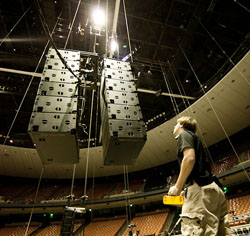
PLAYING IT OUT
I decided on two arrays, each comprised of six Adamson Systems T21 subwoofers, one behind the other in an end-fire formation.
With significantly more output power than most dual-18-in subs on the market, it required less of them to get the desired SPL, and also kept the hangs short.
Four additional T21s were spread across the floor to help fill in some of the gap before the flown subs took over.
The main hangs consisted of 12 Adamson Y18s per side, with four Y10 for down fill and 12 Y10s for out hangs.
The rig was powered by 30 Lab.Gruppen PLM 10000Q amplifiers, with all system DSP done inside the amps.
Determining the exact end-fire spacing to optimize gain, spacing and delay time was a joint effort involving Adamson and it’s distributor in France, DV2. The result was a textbook cardioid pattern from 40 Hz to 80 Hz, where the subs were crossed over. The “EF66” preset, as Adamson called it, spaced the two hangs 66 inches apart around a center frequency of 51 Hz.
To prevent the rig from swinging (and hence changing the precise spacing), a piece of steel pipe was linked between the rear pick point of the downstage hang and the front point of the upstage hang. Cheeseborough clamps allowed us to adjust spacing once the rig was floating.

Finally, a cable bridge constructed of minibeam spanned from the sub hang downstage center to the stage left cable pick, in order to reduce added tow on the hang.
MISSION ACCOMPLISHED
Any reservations were quickly forgotten once we heard the rig. I was afraid that the flown subs might lose some of their “punch,” but that certainly wasn’t the case here. The low-end was extremely tight, even and clean. There was no more than 7 dB of drop-off from the first row to the top of the mezzanine, and more importantly, the ratio of subs-to-mains remained constant, leaving the mix to sound full and clear, no matter where you were located.
Behind the rig, the cardioid pattern performed beautifully. The sections behind the stage were so quiet it almost felt eerie. In the past four years working with Big House, I’ve heard this rig deployed dozens of times, and became used to the large amounts of back pressure these subs typically produce – but not this time. It was practically silent, except for the late 1.5-second reflections coming back from behind front of house.
When all was said and done, we couldn’t have been more pleased with the outcome. It was hands-down the smoothest, tightest and most even low-end I’ve ever gotten out of an arena system. The comments about the superb low-end coverage haven’t stopped coming in, and one production manager told us that it sounded better than the rig a major concert tour brought in just a few weeks prior. Whether or not that statement is true, I don’t know, but I’ll take the compliment nonetheless!

I fully believe in giving credit where credit is due, especially in this industry. We’re fortunate to benefit from some pretty great minds, using their ideas to take things to a new level. I have tremendous respect for people like Dave Rat, who consistently put new concepts out there simply because they’re passionate about live audio, and want to make us all better as a whole.
We are, in a sense, standing on the shoulders of giants. I truly look forward to what future discoveries will be made and how they will continue to improve one of the coolest fields a person could find themselves employed in.
Todd Hartmann is the audio engineering coordinator for the Austin Stone Community Church as well as A1 systems engineer for Big House Sound in Austin, TX.
